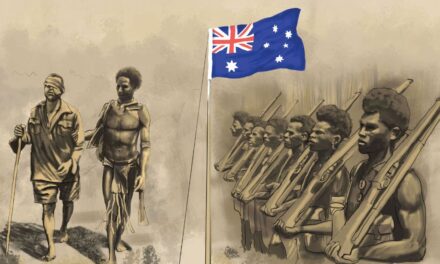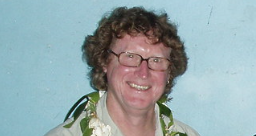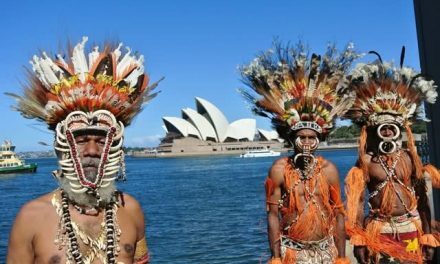‘Infantryman’s calvary where the pain of effort, the biting sweat, the hunger the cheerless shivering nights were made dim by exhaustion’s merciful drug. Surely no war was fought under worse conditions than these. Surely no war has demanded more of a man in fortitude. Even Gallipoli or Crete or the desert.’
Osmar White Wartime
journalist, writing from the track in 1942
When I first trekked Kokoda with a local guide in March 1991, I was struck by the fact that there was no information on the location of places such as Brigade Hill, Butcher’s Ridge, Templeton’s Crossing, Eora Creek, Imita Ridge, Kokoda Gap. Isurava, Deniki, Kokoda, etc. Ever since I was a small boy I could remember thousands of veterans marching behind battle honours emblazoned with these names. I therefore expected to find these places and be able to navigate around the positions with some sort of information booklet or guide.
I expected to see the remnants of the steps up the infamous ‘golden staircase’; to feel the pain of climbing ‘Jap’s Ladder’; to wonder how our diggers felt in their weapon pits on the forward slopes of Butcher’s Ridge as they waited to meet thousands of fanatical Japanese soldiers; to follow the footsteps of Private Bruce Kingsbury as he led a counter attack against the Japs at Isurava; to stand on the ground defended by Charlie McCallum as he stood bravely between the Japs and his men to protect their escape.
I wanted to see where Captain Butch Bissett was machine gunned; where Ben Buckler led his fateful patrol; where Captain Claude Nye and Captain Brett (Lefty) Langridge led their fateful charge at Brigade Hill; where Lieutenant-Colonel Ralph Honner held his famous parade at Menari with ‘Those Ragged Bloody Heroes’ of the 39th Battalion; where Corporal John Metson and Sergeant Lindsay Bear crawled on all fours along the track refusing all offers for help because they had mates ‘a lot worse off than us’!
I hoped to meet ‘fuzzy wuzzy angels’ who saved hundreds of diggers by carrying them across some of the most inhospitable terrain on the planet and say ‘thank you’ to their families in the villages.
Unfortunately, I was to be bitterly disappointed because there was not a single signpost, monument or memorial along the entire track apart from a few plaques placed by regimental associations and a small plinth erected by a Japanese soldier at Launumu – the forming up place for the Japanese attack against the Australians on Butcher’s Ridge and Brigade Hill on 6 September 1942.
I was further disadvantaged by the fact that my PNG guide knew nothing about the war history of the campaign and there were no maps or signs to assist in identifying important sections of the Trail or any of the battle-sites.
I was also struck by the fact that we had neglected those who sacrificed so much for us in Papua New Guinea – the legendary ‘fuzzy wuzzy angels’. I learned that none have been issued with a medal for their service and some claim to have never been paid. When I asked one of the elders about the war on the Trail, he explained that ‘they had lived in peace for generations then one day the Australians and the Japanese came, had a big fight in their backyards, caused a lot of damage in their villages, then went away!’ Our efforts to correct this shameful neglect has been unsuccessful to date however we have been heartened to receive the support of the RSL of Australia – and we will persevere!
The villages along the track are poor and reliant on a basic subsistence economy. They grow food to send to markets in Port Moresby and use the proceeds to support village life which includes building community schools, purchasing rudimentary school supplies and medicine.
It seemed obvious to the people I first led over the track that if we could somehow identify all the battle-sites and train local guides, then young Australian trekkers would want to come – just as they have at Gallipoli over recent years.
We therefore decided to plot the route of the original wartime Trail. During the process of gathering wartime maps and comparing them to our trek notes we discovered that today’s track bypassed ‘Brigade Hill’; that the original ‘golden staircase’ is on a different ridge; and that the battle-site of Isurava was about an hour’s trekking south of where everybody thought it was at the time. There are a number of other areas where today’s track follows a different route from the wartime track.
The 50th anniversary of the Kokoda campaign was a timely reminder of the need to enshrine the values of Kokoda in our national subconscious. Prime Minister Paul Keating was the first Australian Prime Minister ever to visit Kokoda. Who will ever forget the image of him falling to his knees and kissing the ground on the Kokoda plateau!
During our next few treks, we discussed what should be done to properly honour the Kokoda campaign and ensure its legacy is never forgotten. As a result of these discussions, we prepared a list of suggestions to submit to the Federal Government in Canberra. This included recommendations that the original golden staircase be reconnoitered and rebuilt; all the battle-sites be identified with ‘educational’ memorials being placed onsite to tell the story of each battle; significant sites be restored and interpreted; life-size bronze statues to be placed along the track to depict the various actions that took place – a fighting patrol at Templeton’s Crossing – a stretcher party coming out of Eora Creek – a medical team in action at Myola – Bruce Kingsbury in action at Isurava – a salvo serving a cuppa at Nauro – and so on. These would act as haunting reminders of what the spirit of Kokoda is all about.
We submitted that the Kokoda Trail should be proclaimed as a National Memorial Park with the aim of establishing a self-sustaining eco-trekking industry for the Koiari and Orokaiva people who live along it.
The land that traverses the track between McDonald’s Corner and the village of Kokoda is subject to traditional ownership by PNG custom and the borders between the various landowners is often not clear. What is clear is that these people are the traditional custodians of land that is sacred to our shared wartime heritage and such initiatives would provide an incentive for them to protect and maintain the sites that are now sacred to us.
Our next opportunity to put Kokoda on the national – and international – agenda appeared in the early stages of planning for the Olympic Torch Relay by the Sydney Organising Committee for the Olympic Games (SOCOG). With the announcement of the plan for the torch to be flown into each Pacific nation for four hours we put forward a proposal that the Olympic torch should be carried over the Kokoda Trail. SOCOG announced that the relay would be a 100 day ‘celebration’. We submitted that is should have one day set aside for ‘commemoration’ (it would have taken 100 Koiari and Orokaiva runners 10 hours to get it across the track) and the remaining 99 days could be for ‘celebration’!
We then held meetings with senior staff of the SOGOC Olympic Torch Relay organising team and the Federal Minister for Sport and Recreation. Everybody expressed the view that it was a good idea but we soon got the feeling that it was not on their agenda.
As it transpired the idea was rejected out of hand by the Australian ‘Lords of the Rings’ – Michael Knight, Graham Richardson, John Coates et al. Their first attempt to discredit the proposal was to assign the task to a ‘police security’ team who did a reconnaissance of the Trail in a chartered plane and made an ‘expert‘ recommendation that it would be ‘unsafe’. We challenged this decision with yet another media release (Olympic Torch bearers at greater risk of being shot in Sydney than mugged on Kokoda!) questioning their rationale over safety and security concerns.
After much ‘argy bargy’ between us they finally tried the ultimate con job by announcing that the torch would go to the Kokoda Trail. We initially celebrated the idea but were cut short when we looked at the fine print and discovered that it was going to be run from Owers Corner to Port Moresby. We issued yet another media release (SOCOGs spurious rejection of the Kokoda Torch Relay) in an attempt to expose the con but the SOCOG media machine was much more effective than our rearguard action.
As it turned out the all-powerful SOCOG ‘Lords of the Rings’ – effectively steamrolled the proposal. They should have been tarred and feathered – the subsequent Olympic ticketing fiasco exposed their colours and showed what little regard they had for the average digger – we can at least be assured that history will not be as kind to them as it will be to our veterans!
What this exercise proved to me was the superficiality of many ‘influential’ Australians in regard to our military history. They give shallow mealy-mouthed speeches on appropriate days of national significance but when one puts the bite on them to support an ideal, they are suddenly reported as ‘missing-in-action’!
There is no doubt that if the Kokoda campaign had been fought by the United States Army it would now be part of American folklore. The Trail itself would be a shrine dedicated to the leadership, courage, sacrifice, mateship and endurance of the soldiers who fought along it. Names like Bruce Kingsbury, Alan Avery, Lindsay Bear, Charlie McCallum, John Metson, Claude Nye, ‘Lefty’ Langridge, Stan and Butch Bissett, Charlie Butler and so on would be legends of the screen and ingrained in the subconscious of every American just as Davy Crockett, Daniel Boone, Colonel Travis and others were at the battle of the Alamo in 1836.
But it was an Australian campaign and they are Australian names – and for some inexplicable reason it had become a neglected shrine – and they are our forgotten heroes! Approaching the 50th anniversary of the Kokoda campaign journalist Frank Devine reflected on the greatness of our troops at the battle of Isurava in an article titled ‘Australian Thermopylae’ for the Australian newspaper. After recalling the heroic deeds of our young militia troops, he asked why have we let the triumph of the 39th Battalion slip from national legend?
‘God alone knows. After 18 months in existence, the 39th was disbanded and its soldiers sent to other units. No echo remains of our glorious Spartans in Australia’s military structure.’
‘What losses Australia inflicts upon itself by its neglect of past achievement. What vigour a clear memory of our Spartans at our Thermopylae would contribute to national self-esteem. The handful of 39th Battalion survivors are now, says Lex McAulay, ‘just the old blokes at the bowling club.’
‘Recently, the American journalist Patrick Buchanan argued that his country’s finest generation of the 20th century was the one born in the ‘20s, whose members bore the Great Depression as children or teenagers, fought in World War 11 and created the prosperity of the 50s.’
‘When one considers the magnificence of the boy warriors of the 39th Battalion, it is easy to believe that this is Australia’s greatest generation, too.’
The questions posed by Frank Devine in 1991 still haven’t been answered and our attempts to engage the government to rectify the situation would indicate that we have a long way to go. The political duckshoving thus far is reminiscent of our political ‘armchair generals’ of 1942!
On a positive note, media interest over the past 10 years has increased public awareness of the Kokoda campaign. A number of television programs have covered various treks and some interesting books have recently been published. Television producer and director Yahoo Serious has trekked Kokoda three times as part of his research for the first feature film on the campaign – one that is long overdue. It is not surprising that he has to secure funding from overseas sources!
Notwithstanding these negatives we are well advanced with our plans to present a strategic master plan for the development of the Kokoda Trail as a National Memorial Park to the Australian and PNG Governments by Anzac Day 2006.
There is still much work to be done but the following testimonial received from the late Colonel Phil Rhoden OBE, Commanding Officer of the 2/14th Battalion at the Battle of Isurava, makes the journey worthwhile:
“The veterans and I, in particular, are aware of your work over many years in you bringing the events in 1942 to the attention of all who would listen to you and some who would not and were it not for that persistence and endeavour of yours the words ‘courage, endurance, mateship and sacrifice’ would not be at Isurava for all to see.”




